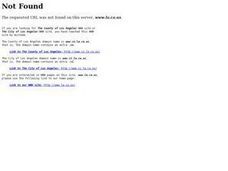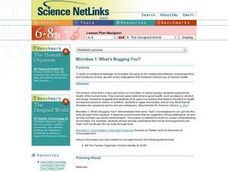Smithsonian Institution
What's the Code? Coding Robot Movements Using Sound
Tap into the desire to learn about computer codes. Pupils apply the Tap Code and the Polybius Square to send secret codes using sound. They design a code that tells a robot what movements to make and then test out their code using one of...
swmcdn
AP US History Test Review
Every major concept, key term, and definition that an AP US history student should know for a test prep session and the big exam is right here in this comprehensive, well-organized study guide.
Code.org
Good and Bad Data Visualizations
Good versus bad data. Pairs rate online collections of data representations from good to bad and then suggest ways to improve the visualizations. The class then creates a list of best practices and common errors in data representations...
Curated OER
Native People of the Caribbean
Eleventh graders use a map and locate and define the Caribbean region and then work in groups to read the passage and timeline. The groups' reader will read the passage aloud and the recorder makes a list of why colonists used slave...
Curated OER
Minoan Pottery - A History Lesson
Accent your next ancient pottery art project with easy-to-follow background information. An article describes the background, significance, and history of Minoan Pottery. It includes links to images, sites and ideas. Tip: This is a great...
Curated OER
English Vocabulary Skills: AWL Sublist 3 - Exercise 4c
In this online interactive English vocabulary skills worksheet, students answer 10 matching questions which require them to fill in the blanks in 10 sentences. Students may submit their answers to be scored.
Desert Discoveries
Creating a Garden Journal
Youngsters create science journals which are used to record observations from the school garden. The goal of this activity is to help kids tune into nature by making daily observations on the growth of the plants, and also to take note...
Curated OER
Kitchen Math - Levels I & II
Identify appropriate abbreviations, food-measurement terminology, techniques, equivalents, and calculate recipe-size adjustments and demonstrate proper measuring techniques. Identify abbreviations Compute equivalents Identify measuring...
Curated OER
Expository --Writing
In this writing worksheet, students investigate the writing process, especially in expository articles. Students examine a piece written for a children's magazine about dinosaurs. Students read about the steps taken to generate it:...
Curated OER
MICROBES 1: WHAT'S BUGGIN YOU?
Middle schoolers use existing knowledge of microbes, focusing on the relationship between microorganisms and foodborne illness, as well as the implications that foodborne illness has on human health.
Curated OER
Maskerade, My Self, And No Other
Learners examine themselves, discover their strong, positive attributes, and recognize areas in need of improvement (since each individual possesses strengths but all people have some weaknesses). They develop self-acceptance, trust in...
Curated OER
Archaeological Inquiry
Students describe what they see as they observe an "artifact". They draw conclusions based on the information gathered to identify what the artifact might be used for and determine how old it might be.
Curated OER
Gyotaku Lesson Plan
Young scholars study the Japanese art of fish painting called Gyotaku while examining the lifestyle of Japanese fishermen at the end of the Edo period. They make a Gyotaku fish print and write a haiku poem using the proper number of...
National First Ladies' Library
There's Only How Much? Rationing in World War II
Students discuss the idea of rationing as a restriction on the amount of something or the frequency with which something may be purchased or used in order to contribute to the greater good of the group which was what happened during...
Curated OER
Bang! You're Alive
Young scholars explore the Big Bang Theory and the Theory of Plate Tectonics. In this history of life lesson, students explain two ways the Theory of Plate Tectonics and the Big Bang are of direct benefits to humans.
Curated OER
Elements of Biology: Organization In Living Systems
Learners explore the recent research on dinosaurs. In this dinosaur lesson students write a report on the new findings and how it has changed ideas on dinosaurs.
Curated OER
France's New Medieval Castle Takes Shape
Young scholars explore how a dream to build a medieval castle came to reality. In this lesson, students read an article about a knight's castle that is being built in France, then complete numerous activities such as a quiz, a debate, a...
Curated OER
The British Empire – Where the Sun Never Set
Students read an article on the British Empire. In this ESL lesson, students explore the British Empire from the 1600's, then work in small groups to complete several activities that reinforce the information learned in the reading.
Curated OER
Kitchen Math - Levels I & II
Learners examine mathematics as an important component of nutrition management and food preparation.
Curated OER
ARTIFACT to ART to GLYPHS
Students study the development of early Latin American civilizations in unit one. The second part of the unit is based on early image-making attempts from the Cro-Magnon to the Peruvian Incas. Students create their own weavings using a...
Curated OER
Exploring Special Lines
Learners compare and order numbers. In this geometry lesson, students write equations for inequalities. They differentiate and apply concepts of triangular properties to solve problems.
Curated OER
"Julie of the Wolves"
Fifth graders research life in Alaska and compare life there to their lives in this instructional activity. They read "Julie of the Wolves." They research through the novel and other reference books facts about the Alaskan climate and...
Curated OER
Benjamin Franklin
In this Benjamin Franklin worksheet, students read a 1 page article on Benjamin Franklin, answer 3 questions with multiple choice answers, fill in 4 blanks to complete 4 facts and answer 2 statements as true or false.

























